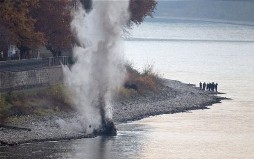 Bomb disposal experts have already had to blow up an incendiary bomb near Cologne and have yet to decide how to deal with a larger bomb spotted lying in 16 inches of water near Koblenz.
Bomb disposal experts have already had to blow up an incendiary bomb near Cologne and have yet to decide how to deal with a larger bomb spotted lying in 16 inches of water near Koblenz.
River traffic was also disrupted earlier this week after a hand grenade was spotted on the banks of the Rhine near Bonn, and authorities along the course of the river have asked people to report any suspicious objects.
During the Second World War the Rhine saw intensive fighting as German troops used it as a barrier to stem the eastern advance of Allied forces.
The danger posed by the munitions has added to the woes of Rhine shipping, which is having to deal with water levels five feet below average as Germany and much of Central Europe feel the effects of one of the driest autumns on record.
At Duisburg the water level on the Rhine fell to 6.4 ft, its lowest level for 100 years, while in Bonn it fell to just 3.8ft.
In Kaub, which stands on a narrow stretch of the Rhine, the level it has dropped to just 1.8ft, and, according to Ralf Schafer of the Water and Shipping Authority, it could sink further by the end of the week.
The low water levels on the river, which is one of Europe’s main transport arteries, have left many boats stranded, and barges have been forced to sail under-loaded to avoid grounding.
“It’s too difficult for ships to move in such low waters. Businesses are being damaged, companies are having to load 4,000 ton capacity ships with a mere 1,000 tons of goods,” Mr Schafer added.
Some river companies have had to halt services all together.
“We stopped running our services on Saturday,” said Susanna Maul from a Rhine ferry company. “At the moment you can see the stones on the bottom of the river.”
The draught has also affected other European waterways. In parts of Bulgaria and Romania the Danube has fallen to its lowest level in 60 years, and shipping on large stretches of the river has ground to a halt.


